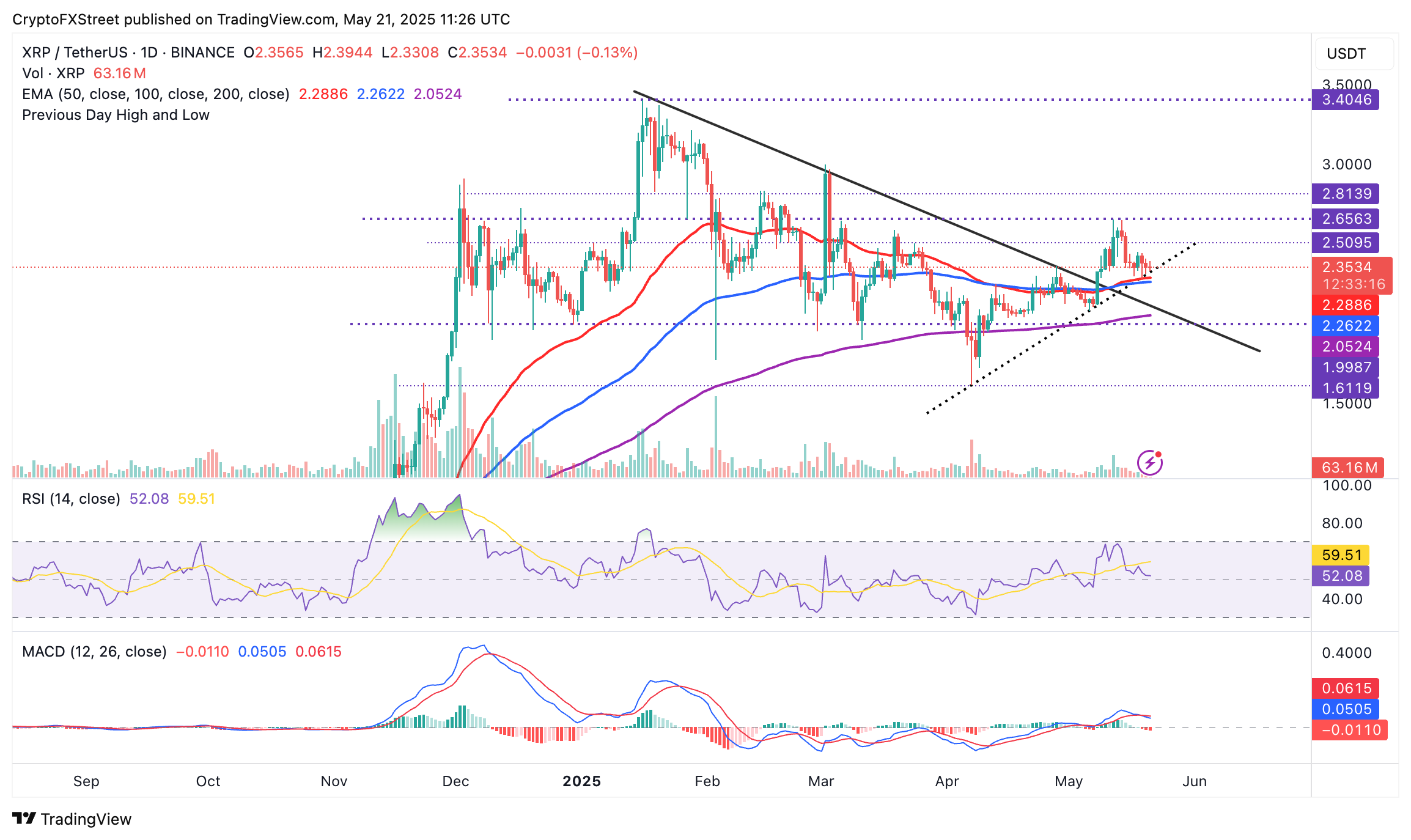Ripple Price Forecast: XRP uptrend targeting $3 at risk amid declining network activity, whale holdings
- XRP's drop from recent highs of $2.65 on May 12 tests the 50-day EMA support as downside risks emerge.
- XRP faces declining network activity amid subdued daily active addresses.
- Large volume holders with between 100,000 and 1 million coins cut back on their holdings as the uptrend falters.
- Strong crypto market sentiment could keep XRP above its 50-day EMA support, boosting the chances of returning to $3.00.
Ripple's (XRP) price faces growing downside risks while hovering at around $2.33 at the time of writing on Wednesday. Its suppressed price action in the last three days reflects range consolidation in the broader cryptocurrency market, even as Bitcoin (BTC) closes in on all-time highs. A closer look at the XRP Ledger shows that network activity has remained subdued, significantly below the levels seen in the first quarter.
XRP faces declining interest as network activity remains muted
As the XRP price broadly consolidates above the short-term support at $2.28, attention is shifting to the XRP Ledger, which, according to Santiment, faces declining network activity.
The Daily Active Addresses metric in the chart below shows the number of newly created addresses on the protocol at approximately 33,400, representing a 95% drop from the first quarter peak of roughly 612,000.
This sharp decline coincided with the drop in the price of XRP from its first-quarter peak of $3.40 to $1.61 amid the tariff-triggered crash on April 7. While the price recovered, reaching $2.65 on May 12 before sliding to the current market rate of $2.33, engagement remains low based on the diminished number of unique addresses joining the network.
 [13-1747827810794.50.28, 21 May, 2025].png)
XRP Active Addresses metric | Source: Santiment
A persistent drop in the addresses joining the XRP Ledger translates to reduced engagement and low demand for the XRP token, stifling potential price increase.
Coincidentally, some cohorts of large volume holders, often referred to as whales, continue to offload their holdings, as illustrated by the Supply Distribution metric in the chart below.
Users with between 100,000 and 1 million coins have been shaving their holdings since the fourth quarter. This whale cohort currently accounts for 10.32% of the total supply, down from 10.76% on March 1 and 11% on November 1.
As the chart below shows, this group of investors started selling aggressively as XRP's price exploded in the fourth quarter and continued to do so in the first quarter, plausibly taking profits.
 [13-1747827833161.12.20, 21 May, 2025].png)
XRP/USD Supply Distribution chart | Source | Santiment
If this aggressive profit-taking continues, it could be difficult for bulls to sustain the uptrend, targeting a return above $3.00 in the mid-term. Moreover, the XRP futures Open Interest (RSI) has fallen to $4.59 billion from its peak of $5.52 billion on May 14.
OI refers to the total number of active derivatives contracts, such as futures or options, that are yet to be settled.

XRP futures open interest | Source| CoinGlass
The subsequent decrease in the trading volume to approximately $4.43 billion points to declining trader interest in XRP. Falling OI and declining volume and price signal shifting sentiment and bearish momentum as market participation fades.

XRP futures trading volume | Source: CoinGlass
Looking ahead: Could XRP break the uptrend and accelerate losses?
XRP's price hovers above the 50-day Exponential Moving Average (EMA) support around $2.28, while bulls struggle to sustain the higher low pattern established since the recovery from the April 7 low at $1.61.
Technical indicators like the Moving Average Convergence Divergence (MACD) affirm the growing bearish grip following the rejection from May's peak of $2.65. A sell signal has been validated with the MACD line (blue) crossing below the signal line (red). If bulls fail to regain control, the expanding red histogram bars could encourage traders to sell XRP, boosting bearish momentum.
The Relative Strength Index (RSI) indicator's downward trend at 52 shows that bears are getting stronger. Further movement below the 50 midline would reinforce the sellers' influence on the token's price.

XRP/USDT daily chart
Meanwhile, the 50-day EMA at around $2.28 and the dotted ascending trendline offer initial support. Should declines intensify, traders could shift attention to lower support areas such as the 200-day EMA at $2.05 and the lowest point in April at $1.61.
Ripple FAQs
Ripple is a payments company that specializes in cross-border remittance. The company does this by leveraging blockchain technology. RippleNet is a network used for payments transfer created by Ripple Labs Inc. and is open to financial institutions worldwide. The company also leverages the XRP token.
XRP is the native token of the decentralized blockchain XRPLedger. The token is used by Ripple Labs to facilitate transactions on the XRPLedger, helping financial institutions transfer value in a borderless manner. XRP therefore facilitates trustless and instant payments on the XRPLedger chain, helping financial firms save on the cost of transacting worldwide.
XRPLedger is based on a distributed ledger technology and the blockchain using XRP to power transactions. The ledger is different from other blockchains as it has a built-in inflammatory protocol that helps fight spam and distributed denial-of-service (DDOS) attacks. The XRPL is maintained by a peer-to-peer network known as the global XRP Ledger community.
XRP uses the interledger standard. This is a blockchain protocol that aids payments across different networks. For instance, XRP’s blockchain can connect the ledgers of two or more banks. This effectively removes intermediaries and the need for centralization in the system. XRP acts as the native token of the XRPLedger blockchain engineered by Jed McCaleb, Arthur Britto and David Schwartz.

